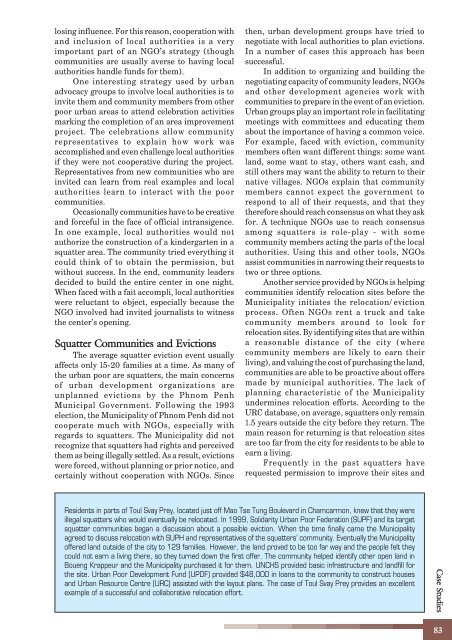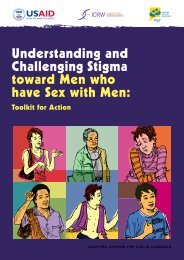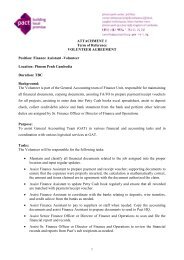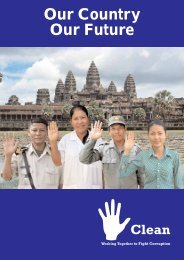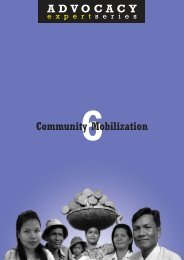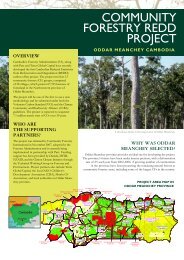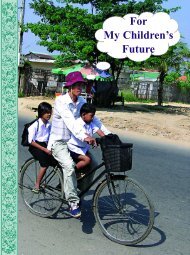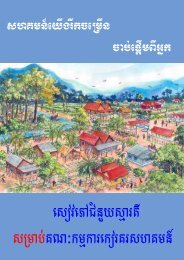Advocacy in Cambodia: Increasing Democratic ... - Pact Cambodia
Advocacy in Cambodia: Increasing Democratic ... - Pact Cambodia
Advocacy in Cambodia: Increasing Democratic ... - Pact Cambodia
Create successful ePaper yourself
Turn your PDF publications into a flip-book with our unique Google optimized e-Paper software.
los<strong>in</strong>g <strong>in</strong>fluence. For this reason, cooperation with<br />
and <strong>in</strong>clusion of local authorities is a very<br />
important part of an NGO’s strategy (though<br />
communities are usually averse to hav<strong>in</strong>g local<br />
authorities handle funds for them).<br />
One <strong>in</strong>terest<strong>in</strong>g strategy used by urban<br />
advocacy groups to <strong>in</strong>volve local authorities is to<br />
<strong>in</strong>vite them and community members from other<br />
poor urban areas to attend celebration activities<br />
mark<strong>in</strong>g the completion of an area improvement<br />
project. The celebrations allow community<br />
representatives to expla<strong>in</strong> how work was<br />
accomplished and even challenge local authorities<br />
if they were not cooperative dur<strong>in</strong>g the project.<br />
Representatives from new communities who are<br />
<strong>in</strong>vited can learn from real examples and local<br />
authorities learn to <strong>in</strong>teract with the poor<br />
communities.<br />
Occasionally communities have to be creative<br />
and forceful <strong>in</strong> the face of official <strong>in</strong>transigence.<br />
In one example, local authorities would not<br />
authorize the construction of a k<strong>in</strong>dergarten <strong>in</strong> a<br />
squatter area. The community tried everyth<strong>in</strong>g it<br />
could th<strong>in</strong>k of to obta<strong>in</strong> the permission, but<br />
without success. In the end, community leaders<br />
decided to build the entire center <strong>in</strong> one night.<br />
When faced with a fait accompli, local authorities<br />
were reluctant to object, especially because the<br />
NGO <strong>in</strong>volved had <strong>in</strong>vited journalists to witness<br />
the center’s open<strong>in</strong>g.<br />
Squatter Communities and Evictions<br />
The average squatter eviction event usually<br />
affects only 15-20 families at a time. As many of<br />
the urban poor are squatters, the ma<strong>in</strong> concerns<br />
of urban development organizations are<br />
unplanned evictions by the Phnom Penh<br />
Municipal Government. Follow<strong>in</strong>g the 1993<br />
election, the Municipality of Phnom Penh did not<br />
cooperate much with NGOs, especially with<br />
regards to squatters. The Municipality did not<br />
recognize that squatters had rights and perceived<br />
them as be<strong>in</strong>g illegally settled. As a result, evictions<br />
were forced, without plann<strong>in</strong>g or prior notice, and<br />
certa<strong>in</strong>ly without cooperation with NGOs. S<strong>in</strong>ce<br />
then, urban development groups have tried to<br />
negotiate with local authorities to plan evictions.<br />
In a number of cases this approach has been<br />
successful.<br />
In addition to organiz<strong>in</strong>g and build<strong>in</strong>g the<br />
negotiat<strong>in</strong>g capacity of community leaders, NGOs<br />
and other development agencies work with<br />
communities to prepare <strong>in</strong> the event of an eviction.<br />
Urban groups play an important role <strong>in</strong> facilitat<strong>in</strong>g<br />
meet<strong>in</strong>gs with committees and educat<strong>in</strong>g them<br />
about the importance of hav<strong>in</strong>g a common voice.<br />
For example, faced with eviction, community<br />
members often want different th<strong>in</strong>gs: some want<br />
land, some want to stay, others want cash, and<br />
still others may want the ability to return to their<br />
native villages. NGOs expla<strong>in</strong> that community<br />
members cannot expect the government to<br />
respond to all of their requests, and that they<br />
therefore should reach consensus on what they ask<br />
for. A technique NGOs use to reach consensus<br />
among squatters is role-play - with some<br />
community members act<strong>in</strong>g the parts of the local<br />
authorities. Us<strong>in</strong>g this and other tools, NGOs<br />
assist communities <strong>in</strong> narrow<strong>in</strong>g their requests to<br />
two or three options.<br />
Another service provided by NGOs is help<strong>in</strong>g<br />
communities identify relocation sites before the<br />
Municipality <strong>in</strong>itiates the relocation/eviction<br />
process. Often NGOs rent a truck and take<br />
community members around to look for<br />
relocation sites. By identify<strong>in</strong>g sites that are with<strong>in</strong><br />
a reasonable distance of the city (where<br />
community members are likely to earn their<br />
liv<strong>in</strong>g), and valu<strong>in</strong>g the cost of purchas<strong>in</strong>g the land,<br />
communities are able to be proactive about offers<br />
made by municipal authorities. The lack of<br />
plann<strong>in</strong>g characteristic of the Municipality<br />
underm<strong>in</strong>es relocation efforts. Accord<strong>in</strong>g to the<br />
URC database, on average, squatters only rema<strong>in</strong><br />
1.5 years outside the city before they return. The<br />
ma<strong>in</strong> reason for return<strong>in</strong>g is that relocation sites<br />
are too far from the city for residents to be able to<br />
earn a liv<strong>in</strong>g.<br />
Frequently <strong>in</strong> the past squatters have<br />
requested permission to improve their sites and<br />
Residents <strong>in</strong> parts of Toul Svay Prey, located just off Mao Tse Tung Boulevard <strong>in</strong> Chamcarmon, knew that they were<br />
illegal squatters who would eventually be relocated. In 1999, Solidarity Urban Poor Federation (SUPF) and its target<br />
squatter communities began a discussion about a possible eviction. When the time f<strong>in</strong>ally came the Municipality<br />
agreed to discuss relocation with SUPH and representatives of the squatters’ community. Eventually the Municipality<br />
offered land outside of the city to 129 families. However, the land proved to be too far way and the people felt they<br />
could not earn a liv<strong>in</strong>g there, so they turned down the first offer. The community helped identify other open land <strong>in</strong><br />
Boueng Krappeur and the Municipality purchased it for them. UNCHS provided basic <strong>in</strong>frastructure and landfill for<br />
the site. Urban Poor Development Fund (UPDF) provided $48,000 <strong>in</strong> loans to the community to construct houses<br />
and Urban Resource Centre (URC) assisted with the layout plans. The case of Toul Svay Prey provides an excellent<br />
example of a successful and collaborative relocation effort.<br />
Case Studies<br />
83


